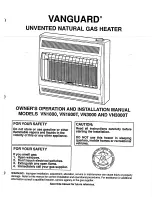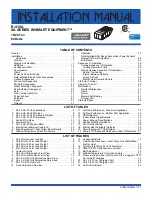
54
by protecting the glass-lined tank from corrosion. Adverse water
quality, hotter water temperatures, high hot water usage, hydronic
heating devices, and water softening methods can increase the rate
of anode rod depletion. Once the anode rod is depleted, the tank
will start to corrode, eventually developing a leak.
Certain water conditions will cause a reaction between the anode
rod and the water. The most common complaint associated with
the anode rod is a “rotten egg smell” produced from the presence
of hydrogen sulfide gas dissolved in the water.
Important:
Do not remove this rod permanently as it will void any
warranties. A special anode rod may be available if
water odor or discoloration occurs.
Note:
This rod may reduce but not eliminate water odor problems.
The water supply system may require special filtration
equipment from a water conditioning company to successfully
eliminate all water odor problems.
Artificially softened water is exceedingly corrosive because the
process substitutes sodium ions for magnesium and calcium ions.
The use of a water softener may decrease the life of the water
heater tank.
The anode rod should be inspected and cleaned annually. Anode
replacement is not covered by warranty.
The following are typical (but not all) signs of a depleted anode rod:
•
The majority of the rods diameter is less than 3/8”.
•
Significant sections of the support wire (approx. 1/3 or more of
the anode rod’s length) are visible.
If the anode rod show signs of either or both, it should be replaced.
Note:
Whether re-installing or replacing the anode rod, check for
any leaks and immediately correct if found.
To replace the anode:
1.
Turn off gas and electric supply to the water heater.
2.
Shut off the water supply and open a nearby hot water faucet to
depressurize the water tank.
3.
Drain approximately 5 gallons of water from tank. See
(page 55) for the procedure. Close drain valve.
4.
Remove old anode rod.
5.
Use Teflon
®
tape or approved pipe sealant on threads and install
new anode rod.
6.
Turn on water supply and open a nearby hot water faucet to purge
air from water system. Check for any leaks and immediately
correct any if found.
7.
Restart the water heater as directed in this manual.
New Unused Anode Rod
Partially-Consumed Anode Rod
Fully-Depleded Anode Rod
Figure 46.
Anode Rod Depletion
TEMPERATURE-PRESSURE RELIEF VALVE TEST
Burn hazard.
Hot water discharge.
Keep clear of Temperature-
Pressure Relief Valve
discharge outlet.
It is recommended that the Temperature-Pressure Relief Valve
should be checked to ensure that it is in operating condition every
6 months.
When checking the Temperature-Pressure Relief Valve operation,
make sure that (1) no one is in front of or around the outlet of the
Temperature-Pressure Relief Valve discharge line, and (2) that the
water discharge will not cause any property damage, as water may
be extremely hot. Use care when operating valve as the valve may
be hot.
To check the temperature-pressure relief valve, lift the lever at the
end of the valve several times. See
. The valve should seat
properly and operate freely.
If after manually operating the valve, it fails to completely reset and
continues to release water, immediately close the cold water inlet to
the water heater and drain the water heater. See
(page 55). Replace the Temperature-Pressure Relief Valve with
a properly rated/sized new one. See
Temperature-Pressure Relief Valve
(page 20) for instructions on replacement.
DISCHARGE PIPE
TEMPERATURE-PRESSURE
RELIEF VALVE
Figure 47. Temperature-Pressure Relief Valve Test
If the Temperature-Pressure Relief Valve on the water heater weeps
or discharges periodically, this may be due to thermal expansion.
Note:
Excessive water pressure is the most common cause of
Temperature-Pressure Relief Valve leakage. Excessive water
system pressure is most often caused by “thermal expansion”
in a “closed system.” See
and
(page 20). The Temperature-Pressure
Relief Valve is not intended for the constant relief of thermal
expansion.
Temperature-Pressure Relief Valve leakage due to pressure build
up in a closed system that does not have a thermal expansion
tank installed is not covered under the limited warranty. Thermal
expansion tanks must be installed on all closed water systems.
DO NOT PLUG THE TEMPERATURE-PRESSURE RELIEF
VALVE OPENING. THIS CAN CAUSE PROPERTY DAMAGE,
SERIOUS INJURY OR DEATH.
Содержание 300 Series
Страница 66: ...66 NOTES NOTES...
Страница 67: ...67 NOTES NOTES...
Страница 68: ...68 Copyright 2020 All rights reserved...















































